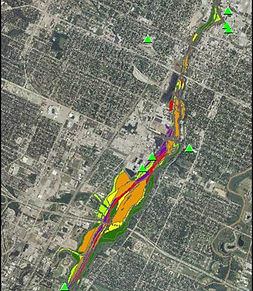
Environmental Forensics and Forensics Chemistry
Experience

Polychlorinated Biphenyl (Aroclors, Homologs, and Congeners)

PCB Replacement Compounds

Polychlorinated Terphenyls

Phosphate Esters

1,4-Dioxane

Chlorinated Dioxins & Furans

Chlorobenzenes, Chlorophenols & Chloroxanthenes

Chlorodioxin-like Compounds

Alkylated Polycyclic Aromatic Hydrocarbons & Biomarkers

Petroleum Hydrocarbons

Metals (B, Li, Hg, Pb, Cd, Hg, Cr)

Stable Isotopes (C13, Cl37, H2, O18, S34, Pb208, Cs123)
Applications
PCB Problems....
Without PCBs
ATS routinely implements forensic chemistry techniques to develop defensible scientific observations and conclusions regarding the source(s) or age of chemical contamination in the environment. Successful environmental forensics requires a combination of in-depth knowledge of analytical methodologies and chemical processes, data interpretation skills, and innovative chemometric techniques to successfully differentiate contaminants in the environment.
Our team has more than 30 years of experience in using chemical forensics to deconvolute contamination involving PCBs, chlorinated dioxins, chlorinated phenols, pesticides, explosives, halogenated solvents, metals, petroleum hydrocarbons, PAHs, MTBE, and other product additives, and many other compounds. Inherent in this expertise is a comprehensive understanding of chemicals and their fate and transport processes. We have more than 10 U.S. and foreign patents issued and pending in the application of this expertise to environmental investigation, source control, and remediation. In that regard, our team has successfully used chemical forensics as part of due diligence investigations for the nature and extent of contamination to successfully identify sources with toxicological significance on the follow success story example projects:
Success Stories - Environmental Forensics and Forensics Chemistry

Kalamazoo River - Marshall, Michigan
Environmental forensics site assessment in support of remediation. Constituents of interest included: alkylated polycyclic aromatic hydrocarbons, petroleum biomarkers, and metals.

Lower Fox River - Green Bay, Wisconsin
Environmental forensics site assessment in cost recovery and sediment contamination divisibility harm and cost apportionment lawsuit. Constituents of interest included PCB, PCB congeners, trichlorobenzene, tetrachlorobenzene, methyl isopropyl biphenyl, SantoSol, SureSol, and Alkylate 215.

Tittabawassee River - Midland, Michigan
Remedial investigation and environmental forensics assess of the Tittabawassee River sediments and floodplain soils. Constituents of interested included: 2,3,7,8-tetrachlorodibenzo-p-dioxin, 2,3,7,8-tetrachlorodibenzo-p-furan, alkylated polycyclic aromatic hydrocarbons, chlorophenols, chlorobenzenes.

Woonasquatucket River - Providence, Rhode Island
Environmental forensics site assessment. Constituents of interest included: chlorodioxins, chlorofurans, and chloroxanthenes.

Indian Refinery Superfund Site - Lawrenceville, Illinois
Environmental forensics site assessment for defense in tort and cost recovery lawsuit. Constituents of interest included: volatile organics and petroleum hydrocarbons.

Soo Line Disposal Site - Minneapolis, Minnesota
Forensics environmental site assessment for the presences of hydrocarbons, PCB, synthetic chemicals and solvents.
Other Success Stories
-
Grand Marsh Pipeline Release, Enbridge Energy, Grand Marsh, Wisconsin (alkylated PAH and petroleum biomarkers)
-
Hayton Area Remediation Project, New Holstein, Wisconsin (PCB and chlorobenzenes)
-
Kysor Industrial Superfund, Cadillac, Michigan (trichloroethylene, trichloroethanoic acid, xylenes, tetrachloroethylene, and chromium)
-
North Bronson Industrial Area Superfund Site, Bronson, Michigan (1,2-dichloroethylene, trichloroethylene, tetrachloroethylene, and metals)
-
Rice Insulation vs. Westinghouse, Milwaukee, Wisconsin (2,3,7,8-tetrachlorodibenzo-p-dioxin, chlorobenzenes, PCB, and VOC);
-
Spearhead Pipeline Highway 71 Crossing, Enbridge Energy, Flanagan Missouri (alkylated PAH and petroleum biomarkers)
-
Venice Park LF, Lennon, Michigan (Freons, trichloroethylene, and tetrachloroethylene)
-
Confidential Landfill, Lansing, Michigan (1,4-Dioxane, VOC, lithium, and boron)
-
Waukegan Harbor, Waukegan, Illinois (PCB, PAH, trichloroethene, and cyanide)

Litigation Support

Divisibility & Liability Apportionment

Chemical Fate & Transport

Remedial Investigation

Ecological & Environmental Risk Assessment

Exposure Assessment

Natural Resources Damage Assessment

Oil Spill Assessment

Feasibility Assessment/EECA

Remediation
PCB In Surface Sediments

PCB At Depth In Sediments


